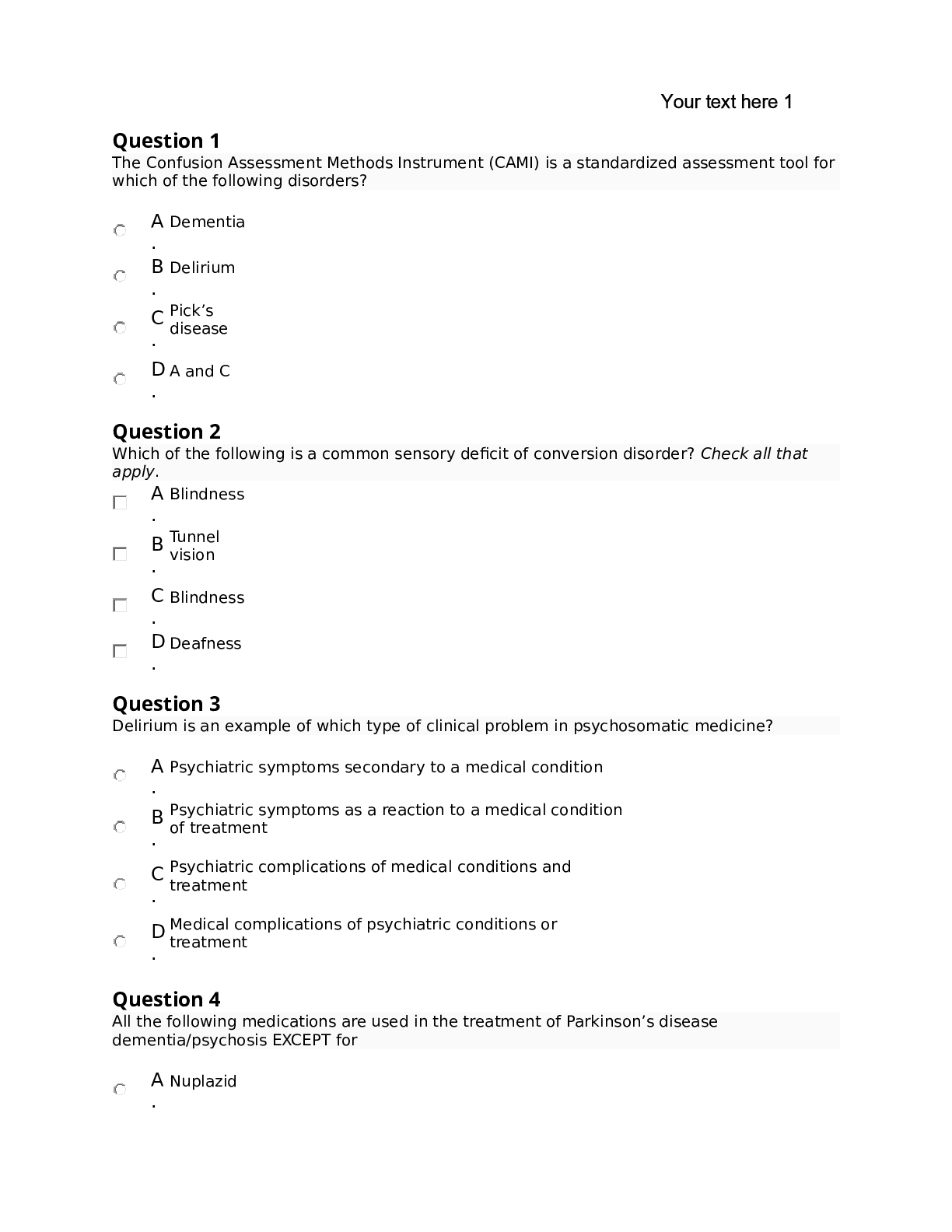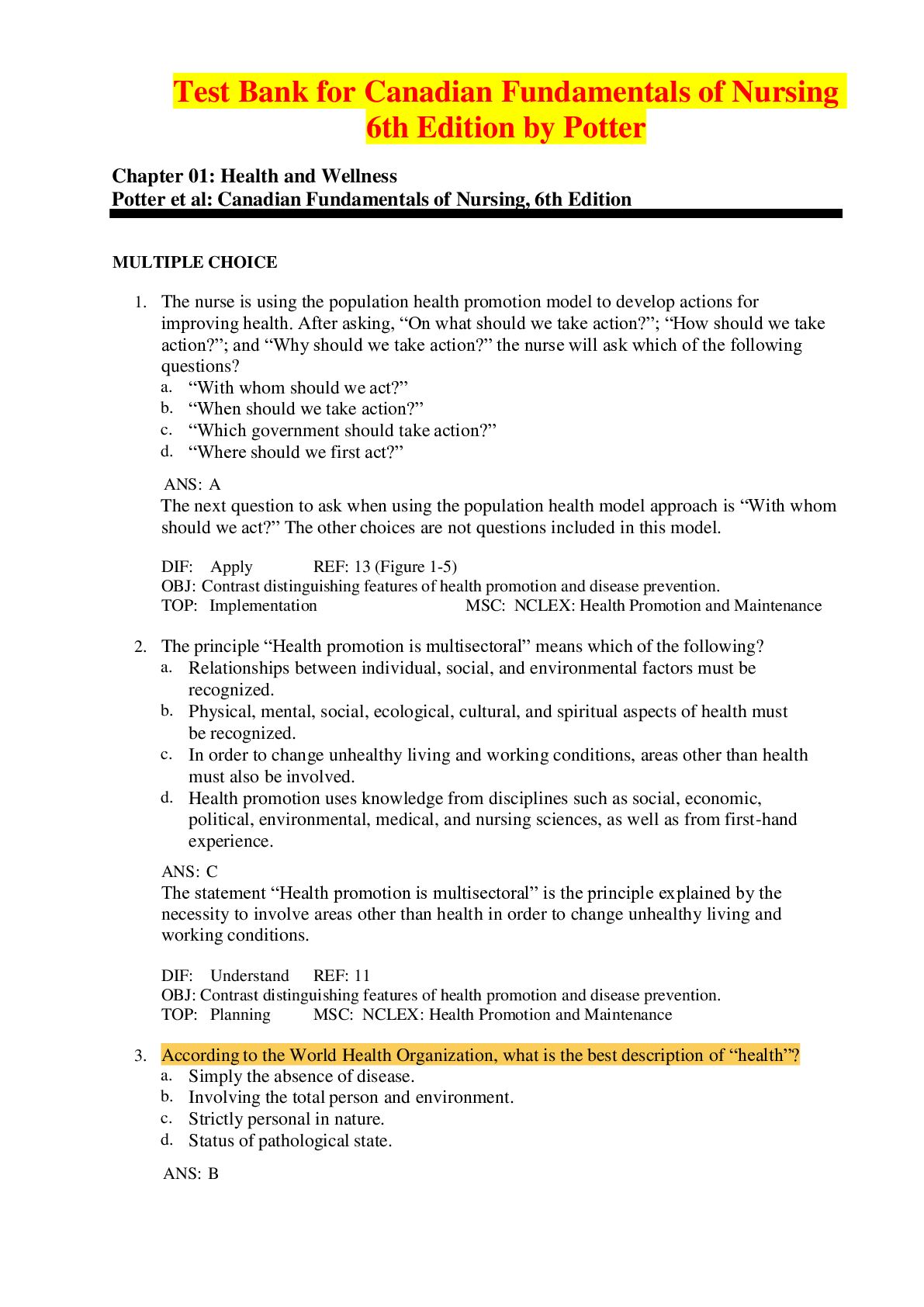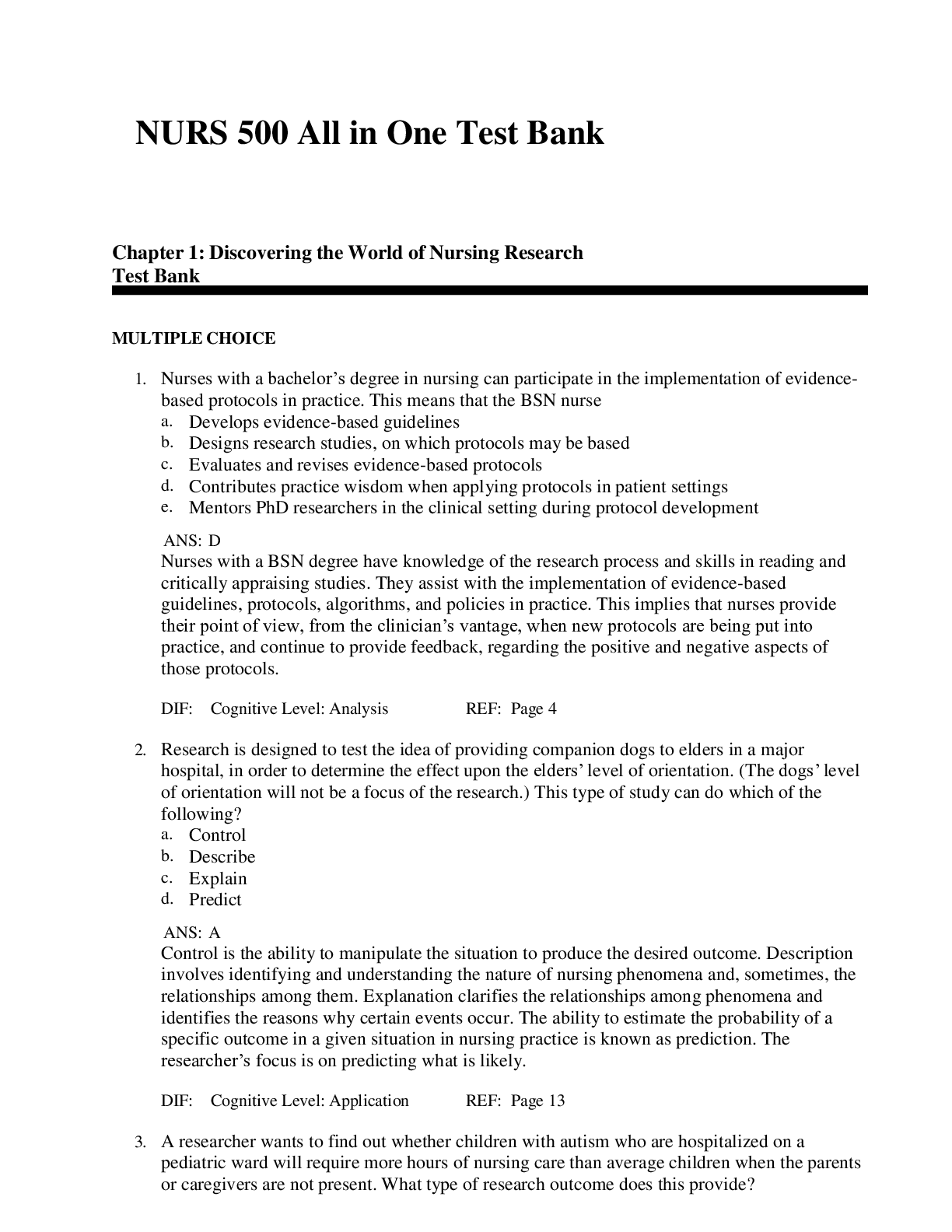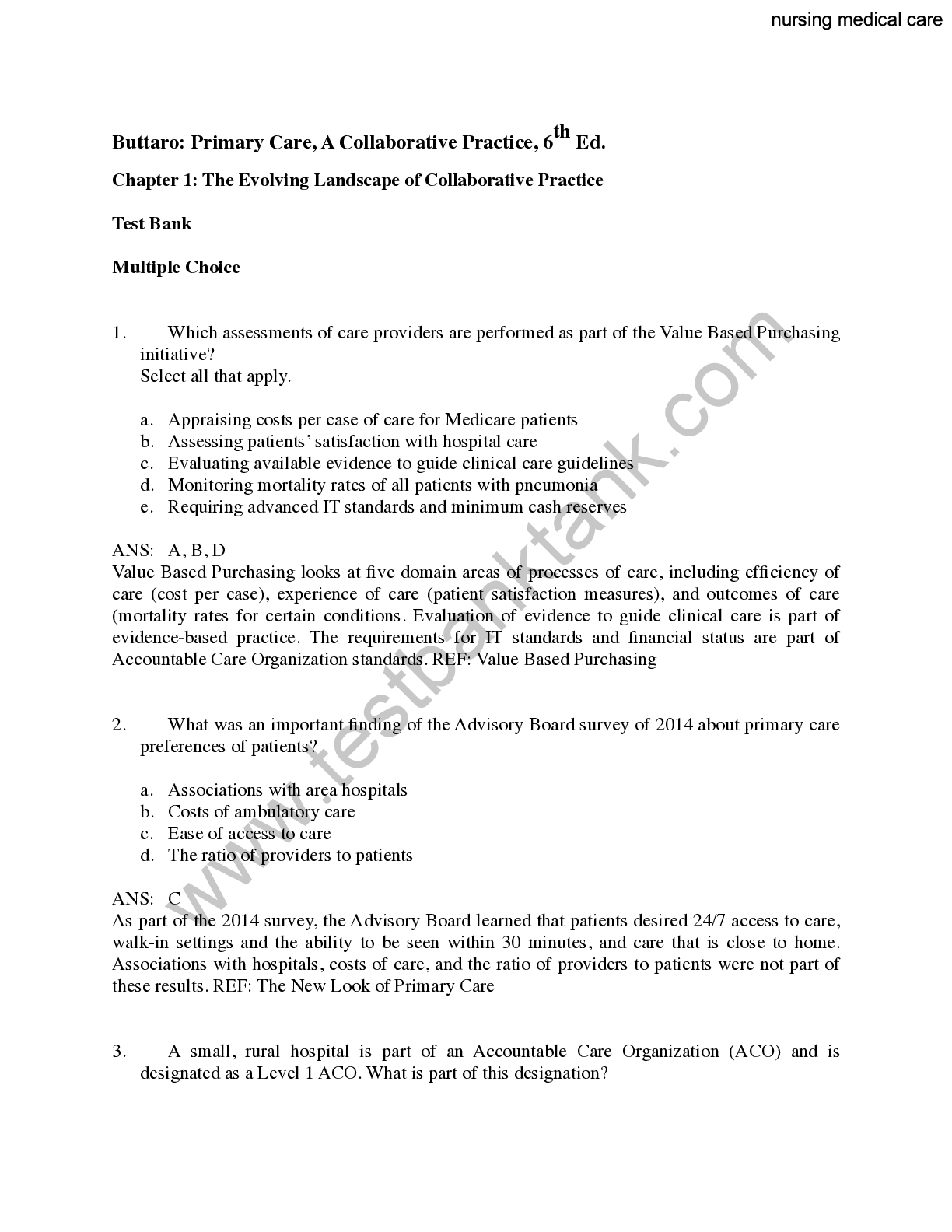Health Care > TEST BANK > N675 Final Exam questions and answers Acute Care | Test Bank – EENT (All)
N675 Final Exam questions and answers Acute Care | Test Bank – EENT
Document Content and Description Below
N675 Final Exam questions and answers Acute Care | Test Bank – EENT N675 Final Exam Acute Care Exam 1 Test Bank Week 1-14 Week 1 – EENT Week 2 – Pulmonary Week 3 – Endocrinology Week 4 – Ca... rdiovascular (CV) Week 5 – Gastrointestinal (GI) Week 6 – Genitourinary (GU) Week 7 – Gynecology (GYN) and Sexually Transmitted Infections (STI) Week 8 – Obstetrics (OB) Week 9 – Geriatric (GERI) Week 10 – Mental Health Conditions and Psychiatric Disorders Week 11 – Neurology Week 12 – Dermatology Week 13 – Pediatrics Week 14 – Musculoskeletal (MSK) Acute Care Exam 1 Week 1 – EENT A primary care provider notes painless, hard lesions on a patient’s external ears that expel a white crystalline substance when pressed. What diagnostic test is indicated? Rheumatoid factor Endocrine studies Biopsy of the lesions Uric acid chemical profile A patient has painful oral lesions and the provider notes several white, verrucous lesions in clusters throughout the mouth. What is the recommended treatment for this patient? Oral hygiene measures Nystatin oral suspension Surgical excision Oral acyclovir A patient has sore throat, a temperature of 38.5° C, tonsillar exudates, and cervical lymphadenopathy. What will the provider do next to manage this patient’s symptoms? Prescribe empiric penicillin Perform a rapid antigen detection test Refer to an otolaryngologist Order an antistreptolysin O titer A 61 year old male presents with a 12 hour history of extremely painful left red eye. The patient complains of blurred vision, haloes around lights, and vomiting. It began yesterday evening. On exam, the eye is red, tender and inflamed. The cornea is hazy and pupil reacts poorly to light. The most likely diagnosis in this patient is: Macular degeneration Acute angle glaucoma Increased intracranial pressure Detached cornea A patient has recurrent epistaxis without localized signs of irritation. Which laboratory tests may be performed to evaluate this condition? (Select all that apply.) CBC with platelets BUN and creatinine PT and PTT Liver function tests PT/INR A patient reports a feeling of fullness and pain in both ears and the practitioner elicits exquisite pain when manipulating the external ear structures. What is the likely diagnosis? Chronic otitis externa Acute otitis externa Otitis media with effusion Acute otitis media Patient has been diagnosed with acute rhinosinusitis. Symptoms began 3 days ago. Based on the most likely etiology, how should this patient be managed? Azithromycin and decongestant Decongestant and analgesic Levofloxacin Amoxicillin with clavulanate The vast majority of rhinosinusitis is of viral etiology, antibiotics would not be helpful and would only lead to continued antibacterial resistance. If symptoms persist for longer than 10 days, reevaluation is necessary with possible antibiotics at that time A 20-year-old male of Hispanic descent who reports a history of a cold that resolved 2 weeks ago except for a dry cough and pain over his right cheek that worsens when he bends down. The patient denies fever. The patient tells you that he is very allergic to Keflex and erythromycin. Vital signs are stable except temperature is 99.2°F. Which showed the following conditions is most likely? Fever secondary to previous viral URI Acute sinusitis Acute bronchitis Hay fever Patient's symptoms match most closely to acute sinusitis which includes cough, facial pain, low- grade fever An adult patient has epiglottitis secondary to a chemical burn. Which medication will be given initially to prevent complications? Chloramphenicol biopsyrecu Dexamethasone Metronidazole Clindamycin What are factors associated with acute suppurative parotitis? (Select all that apply.) Anticholinergic medications Diabetes mellitus Radiotherapy Hypervolemia Allergies A 39 year old has a sudden onset of painful right red eye. He reports sensitivity to light and the sensation of a foreign body, though his history for a foreign body is negative. He does not wear contact lenses. How should the NP manage this? Observe for 24 hours if visual acuity is normal Treat for bacterial conjunctivitis Treat for viral conjunctivitis Refer to ophthalmology No clear diagnosis can be made from signs/symptoms, but there are several red flags. collectively the red flags necessitate a referral. There is no mention of eye discharge necessary for conjunctivitis. Red flags present point more towards active corneal process although glaucoma should also be a differential. A 17-year-old has a complaint of ear pain. If he has otitis externa, which complaint is most likely/most common? Concurrent URI Fever Difficulty hearing TV Tragal pain A patient has an initial episode otitis external associated with swimming. The patient’s ear canal is mildly inflamed and the tympanic membrane is not involved. Which medication will be ordered? Cipro HC Neomycin Fluconazole Vinegar and alcohol A patient has gingival inflammation with several areas of separate ulceration and a small amount of purulent discharge. What is required to diagnose this condition? Culture and sensitivity Tzank smear Physical examination Microscopic exam of oral scrapings A patient reports tooth pain in a lower molar and the provider notes a mobile tooth with erythema and edema of the surrounding tissues without discharge. Which is the initial course of action by the provider? Recommend oral antiseptic rinses and follow up in one week Perform an incision and drainage of the edematous tissue Prescribe amoxicillin and refer to a dentist in 2 to 3 days Refer to an oral surgeon for emergency surgery A patient presents to your clinic with a painless red eye. Her vision is normal, but her sclera has a blood red area. What is this termed? Conjunctivitis Glaucoma Acute iritis Subconjunctival hemorrhage Which physical examination finding suggests viral rather than bacterial parotitis? Unilateral edema of parotid glands Enlargement and pain of affected glands Gradual reduction in saliva production Clear discharge from Stensen’s duct A child is hit with a baseball bat during a game and sustains an injury to the nose, along with a transient loss of consciousness. A health care provider at the game notes bleeding from the child’s nose and displacement of the septum. What is the most important intervention at this time? Immobilize the child’s head and neck and call 911 Turn the child’s head to the side to prevent aspiration of blood Place nasal packing in both nares to stop the bleeding Apply ice to the injured site to prevent airway occlusion A pediatric patient has otalgia, fever of 38.8° C, and a recent history of upper respiratory examination. The examiner is unable to visualize the tympanic membranes in the right ear because of the presence of cerumen in the ear canal. The left tympanic membrane is dull gray with fluid levels present. What is the correct action? Remove the cerumen and visualize the tympanic membrane Perform a tympanogram on the right ear Recommend symptomatic treatment for fever and pain Treat empirically with amoxicillin 80 to 90 mg/kg/day A patient presents with findings of pain, warmth, redness, and swelling below the inner canthus toward nose. Tearing is present and when pressure is applied to the lacrimal sac, purulent discharge from the puncta is noted. This is suggestive of: Belpharitis A chalazion A hordeolum Dacryocystitis Group A strep pharyngitis: Is commonly accompanied by inflamed uvula Can be accompanied by abdominal pain Is characterized by single symptom Usually does not have exudative symptoms Group A strep is usually accompanied by multiple symptoms with abrupt onset. GI symptoms are common such as nausea, vomiting, no abdominal pain. Inflamed uvula is not common Which symptoms may occur with vestibular neuritis? (Select all that apply.) Nausea and vomiting Disequilibrium Fever Tinnitus Hearing loss A patient who has acute suppurative parotitis has been taking amoxicillin-clavulanate for 4 days without improvement in symptoms. The provider will order an antibiotic for Methicillin-resistant S. aureus. Which other measure may be helpful? Discouraging chewing gum Topical corticosteroids Cool compresses Surgical drainage A NP preforms a fundoscopic exam. He identifies small areas of dull, yellowish-white coloration in the retina. What might these be? Cotton wool spots Hemorrhages Exudates Microaneurysm The provider sees a child with a history of high fever and sore throat. When entering the exam room, the provider finds the child sitting in the tripod position and notes stridor, drooling, and anxiety. What is the initial action for this patient? Administer empiric intravenous antibiotics and steroids Obtain an immediate consultation with an otolaryngologist Perform a thorough examination of the oropharynx Have the child lie down and administer high-flow, humidified oxygen A patient reports ear pain after being hit in the head with a baseball. The provider notes a large perforated tympanic membrane. What is the recommended treatment? Prescribe analgesics and follow up in 1 to 2 days Order antibiotic ear drops if signs of infection occur Refer the patient to an otolaryngologist for evaluation Reassure the patient that this will heal without problems Papilledema is noted n a patient with a headache. What is the importance of papilledema in this patient? it is not related to the headache this is a common finding in patients with headache it is an incidental finding in patient with migraines It could be an important finding in this patient A patient has seasonal rhinitis symptoms and allergy testing reveals sensitivity to various trees and grasses. What is the first-line treatment for this patient? Intranasal steroids Antihistamine sprays Intranasal comolyn Oral antihistamine A patient with gingival inflammation with several areas of separated ulceration and a small amount of purulent discharge. What is required to diagnose this condition? Microscopic exam of oral scrapings Physical examination Tzank smear Culture and sensitivity A 70 year old male has a yellowish, triangular nodule near the iris. This is probably: A chalazion A pinguecula A stye Subconjunctival hemorrhage. A 32-year-old patient is a newly diagnosed diabetic. She has developed a sinus infection. Her symptoms have persisted for 10 days. 6 weeks ago, she was treated with amoxicillin for a URI. It cleared without incident. Which be recommended today? Prescribe amoxicillin again Do not prescribe an antibiotic, only a decongestant as indicated Prescribe amoxicillin-clavulanate today Prescribe a decongestant and an antihistamine A patient has recurrent sneezing, alterations in taste and smell, watery, itchy eyes, and thin, clear nasal secretions. The provider notes puffiness around the eyes. The patient’s vital signs are normal. What is the most likely diagnosis for this patient? Allergic rhinitis Acute sinusitis Viral rhinitis Chronic sinusitis The patient presents with complaints of morning eyelash crusting and itchy red eyes. It began on the left and now has become bilateral. Based on the most likely diagnosis, what should the NP tell the caregivers about this condition? Anterior cervical lymphadenopathy is common This usually begins as a viral infections Pain is normal in the affected eye It produces blurred vision in the affected eye An adolescent has fever, chills, and a severe sore throat. On exam, the provider notes foul-smelling breath and a muffled voice with marked edema and erythema of the peritonsillar tissue. What will the primary care provider do? Perform a rapid strep and throat culture Refer the patient to an otolaryngologist Prescribe empiric oral antibiotics Evaluate for possible epiglottitis Which patient may be given symptomatic treatment with 24 hours follow-up assessment without initial antibiotic therapy? A 4 year old, afebrile child with bilateral otorrhea A 6 month old with fever of 39.2° C, poor sleep and appetite and bulging TM A 36 month old with fever of 38.5° C, mild otalgia, and red, non-bulging TM A 5 year old with fever of 38.0° C, severe otalgia, and red, bulging TM A patient has nasal congestion, fever, purulent nasal discharge, headache, and facial pain and begins treatment with amoxicillin-clavulanate. At a follow-up visit 10 days after initiation of treatment, the patient continues to have purulent discharge, congestion, and facial pain without fever. What is the next course of action for this patient? A referral to an otolaryngologist A trial of azithromycin A CT scan of the paranasal sinuses A second course of amoxicillin-clavulanate A patient reports several episodes of acute vertigo, some lasting up to an hour, associated with nausea and vomiting. What is part of the initial diagnostic workup for this patient? Auditory brainstem testing Electrocochleography Vestibular testing Audiogram and MRI A patient has two palpable, tender, left preauricular nodes that are about 0.5cm in diameter. What condition might this be associated with? Ear infection Conjunctivitis Ulceration on the tongue Sore throat A kindergarten teacher was diagnosed with acute streptococcal pharyngitis. On exam, her throat is bright red color with no tonsillar exudate, and clear mucus is seen on the lower nasal turbinates. The urinalysis shows a large amount of white blood cells and is positive for nitrates. The patient has a significant sulfa allergy and thinks she is also allergic to penicillin. Which with the following is the best treatment choice? Levofloxacin Amoxicillin–clavulanic acid Trimethoprim–sulfamethoxazole Clarithromycin During routine physical exam of an elderly woman, a triangular thickening of the bulbar conjunctiva on the temporal side is noted to be encroaching on the cornea. She denies any eye pain or visual changes. Which of the following is most likely? Corneal arcus Pterygium Chalazion Pinguecula Group A strep pharyngiitis: Can be accompanied by abdominal pain Group A strep is usually accompanied by multiple symptoms with abrupt onset. GI symptoms are common such as nausea, vomiting, no abdominal pain. Inflamed uvula is not common A 70 year old male patient complains of a bright red colored spot that has been present in his left eye for 2 days. He denies eye pain, visual changes, or headaches. He ha a new onset cough from a recent URI. The only medicine he is taking is aspirin 1 tablet daily. Which of the following actions is appropriate follow up for this patient? Refer the patient to an opthalmologist Refer the patient to an optometrist Prescribe an ophthalmic antibiotic solution Advise the patient that the condition is benign and will resolve spontaneously A patient reports painful oral lesions 3 days after feeling pain and tingling in the mouth. The provider notes vesicles and ulcerative lesions on the buccal mucosa. What is the most likely cause of these symptoms? 1. Herpes simplex virus 2. Bacterial infection 3. Candida albicans 4. Human papillomavirus A patient diagnosed with strep throat received a prescription for azithromycin. She has not improved in 48 hours. What course of action is acceptable? 1. Different macrolide antibiotic should be prescribed 2. Penicillin or cephalosporin with beta-lactamase coverage should be considered 3. The patient should wait another 24 hours for improvement 4. That antibiotics should be changed to a first generation cephalosporin A patient is concerned about frequent nasal stuffiness and congestion that begins shortly after getting out of bed in the morning. The patient denies itching and sneezing. A physical examination reveals erythematous nasal mucosa with scant watery discharge. What treatment will the provider recommend for this patient? 1. Consultation for immunotherapy 2. Oral antihistamines each morning 3. Oral decongestants as needed 4. Daily intranasal steroids A patient has bilateral bleeding from the nose with bleeding into the pharynx. What is the initial intervention for this patient 1. Assess airway safety and vital signs 2. Clear the blood with suction to identify site of bleeding 3. Apply firm, continuous pressure to the nostrils 4. Have the patient sit up straight and tilt the head forward A patient presents to your clinic with a painless red eye. Her vision is normal, but her sclera has a blood red area. What is this termed? 1. Acute iritis 2. Conjunctivitis 3. Subconjunctival hemorrhage 4. Glaucoma During a routine physical examination, a provider notes a shiny, irregular, painless lesion on the top of one ear auricle and suspects skin cancer. What will the provider tell the patient about this lesion? It is benign and will not need intervention. Immediate surgery is recommended. This is most likely malignant. A biopsy should be performed. A patient with allergic rhinitis develops acute sinusitis and begins treatment with an antibiotic. Which measure may help with symptomatic relief for patients with underlying allergic rhinitis? Oral mucolytics Intranasal steroids Saline solution rinses Topical decongestants A 32-year-old patient is a newly diagnosed diabetic. She has developed a sinus infection. Her symptoms have persisted for 10 days. 6 weeks ago, she was treated with amoxicillin for a URI. It cleared without incident. Which be recommended today? Prescribed amoxicillin–clavulanate today Prescribed amoxicillin again Prescribe a decongestant and an antihistamine Do not prescribe an antibiotic, only a decongestant as indicated [Rationale: Amoxicillin is not indicated when a beta-lactamase producing organism and suspected, this is the case as patient took antibiotics 6 weeks ago. Amoxicillin–clavulanate is a good choice as it covers a beta-lactamase producers. And bacteria etiology is suspected as symptoms have persisted for 10 days. A decongestant can be added, however this does not substitute antibiotics in this case] A patient has been taking amoxicillin for treatment of a dental abscess. In a follow-up visit, the provider notes edema of the eyelids and conjunctivae. What is the next action? Hospitalize the patient for an endodontist consultation Suggest using warm compresses to the eyes for comfort Recommend follow up with a dentist in 2 to 3 days Prescribe amoxicillin clavulanate for 10 to 14 days A 58 year old farmer presents with a wedge shaped, pinkish, clear growth on the nasal side of his eye. He states that it has been present for a while, but only recently began to feel as if a foreign body was in his eye. This is probably a: Pterygium Xanthelasma Stye Pinguecula A 39 year old has a sudden onset of painful right red eye. He reports sensitivity to light and the sensation of a foreign body, though his history for a foreign body is negative. He does not wear contact lenses. How should the NP manage this? Treat for viral conjunctivitis Refer to ophthalmology Treat for bacterial conjunctivitis Observe for 24 hours if visual acuity is normal No clear diagnosis can be made from signs/symptoms, but there are several red flags. collectively the red flags necessitate a referral. There is no mention of eye discharge necessary for conjunctivitis. Red flags present point more towards active corneal process although glaucoma should also be a differential A child has recurrent impaction of cerumen in both ears and the parent asks what can be done to help prevent this. What will the provider recommend? Removing cerumen with a cotton-tipped swab Try thermal-auricular therapy when needed Use an oral irrigation tool to remove cerumen Clean the outer ear and canal with a sof t cloth A screening audiogram on a patient is abnormal. Which test may the primary provider perform next to further evaluate the cause of this finding? Speech reception test Impedance audiometry Pure tone audiogram Tympanogram A 12-year-old complains of itching in his right ear and pain when the pinna is pulled or the tragus is pushed. Examination reveals slight redness in the ear canal with a clear odorless fluid. This is suggestive of: Otitis externa Ear pain when pinna is pulled or tragus is pushed is indicative of otitis externa. Clear fluid is not indicative of pus formation such as with ruptured tympanic membrane. A patient is suspected of having vestibular neuritis. Which finding on physical examination is consistent with this diagnosis? Vertigo with changes in head position Facial palsy and vertigo Fluctuating hearing loss and tinnitus Spontaneous horizontal nystagmus A 20-year-old male of Hispanic descent who reports a history of a cold that resolved 2 weeks ago except for a dry cough and pain over his right cheek that worsens when he bends down. The patient denies fever. The patient tells you that he is very allergic to Keflex and erythromycin. Vital signs are stable except temperature is 99.2°F. Which showed the following conditions is most likely? Fever secondary to previous viral URI Hay fever Acute bronchitis Acute sinusitis Acute otitis media can be best diagnosed by identifying which otic characteristic(s)? Cloudy, bulging TM with impaired mobility Opacity and erythema of the tympanic membrane Decreased mobility of the tympanic membrane Marked redness of the tympanic membrane Cloudy, bulging TM with impaired mobility is the best predictor for AOM. Decreased mobility of TM can be a result of fluid behind the TM, as in middle ear effusion. A patient complains of otalgia and difficulty hearing from one ear. The provider performs an otoscopic exam and notes a dark brown mass in the lower portion of the external canal blocking the patient’s tympanic membrane. What is the initial action? Ask the patient about previous problems with that ear. During an eye exam of a 50 year old hypertensive patient who is complaining of an onset of a severe headache, you find that the borders of the disc margins on both eyes are blurred. What is the name of this clinical finding? Papilledema. A provider is recommending a cerumenolytic for a patient who has chronic cerumen buildup. The provider notes that the patient has dry skin in the ear canal. Which preparation is FDA approved for this use? Carbamide peroxide Mineral oil Hydrogen peroxide Liquid docusate sodium A patient reports a sudden onset of sore throat, fever, malaise, and cough. The provider notes mild erythema of the pharynx and clear rhinorrhea without cervical lymphadenopathy. What is the most likely cause of these symptoms? Viral pharyngitis Infectious mononucleosis Allergic pharyngitis Group A streptococcus A 93 year old demented adult has been recently treated for an upper respiratory infection but drainage from the right nostril persists. What should the NP suspect? Presence of foreign body Allergic rhinitis Unresolved URI Dental caries The NP preforms a fundoscopic exam on a patient who has recently been diagnosed with hypertension. What is the significant of AV nicking? This is indicative of long-standing hypertension This is a normal variant This is indicative of retinal detachment The patient should be screened for diabetes While checking for the red reflex on a 3 year old boy during a well child visit, the NP notes a white reflection on the child's left pupil. Which of the following conditions should be ruled out? Retinoblastoma of the lef t eye Color blindness of the left eye Unilateral strabismus Unilateral cataracts Papilledema is noted in a patient with a headache. What is the importance of papilledema in this patient? It could be an important finding in this patient it is an incidental finding in patient with migraines this is a common finding in patients with headache it is not related to the headache Papilledema could represent swelling of the optic nerve head and disc secondary to increased intracranial pressure (ICP). The cardinal symptom of ICO is a headache; papilledema is a secondary finding. It is not a common finding in patient with general headache A provider performs a nasal speculum examination on a patient who sustained nasal trauma in a motor vehicle accident. The provider notes marked swelling of the nose, instability and crepitus of the nasal septum with no other facial bony abnormalities and observes a rounded bluish mass against the nasal septum. Which action is necessary at this time? Urgent drainage of the mass CT scan of facial structures Ice packs to reduce facial swelling Surgery to reduce the nasal fracture Week 2 – Pulmonary A young adult, previously healthy clinic patient has symptoms of pneumonia including high fever and cough. Auscultation reveals rales in the left lower lobe. A chest radiograph is normal. The patient is unable to expectorate sputum. Which treatment is recommended for this patient? Empiric treatment with a macrolide antibiotic A 22 year old tall, thin and athletic man comes into your primary care clinic complaining of pain with breathing and progressively worsening shortness of breath. In order of sequence, what will be your next steps? -Obtain more history, auscultate the lungs and send pt to the ER for a stat CXR and further evaluation. -Obtain more history, and immediately send him to the ER A patient reports coughing up a small amount of blood after a week of cough and fever. The patient has been previously healthy and does not smoke or work around pollutants or irritants. What will the provider suspect as the most likely cause of this patient’s symptoms? Infection Patients with pneumonia reports that he has rust-colored sputum. With pathogen should the nurse practitioner suspect? Streptococcus pneumoniae Clinical description of mucus does not really help and clinical decision making regarding pneumonia, but certain clinical characteristics are associated with specific types of pneumonia. Scant or watery sputum is associated with atypical pathogens like mycoplasma and clamydophila. Thick, discolored sputum may be associated with bacterial pneumonia. A young adult patient without a previous history of lung disease has an increased respiratory rate and reports a feeling of “not getting enough air.” The provider auscultates clear breath sounds and notes no signs of increased respiratory effort. Which diagnostic test will the provider perform initially? Complete blood count A 65-year-old patient who has not had an influenza vaccine is exposed to influenza and comes to the clinic the following day with fever and watery, red eyes. What will the provider do initially? Observe for improvement or worsening for 24 hours Begin treatment with an antiviral medication Administer LAIV influenza vaccine Perform a nasal swab for RT-PCR assay Which patient might be expected to have the worst FEV1? Patient with bronchiolitis A controlled asthma patient A 65 her old with emphysema A 60-year-old with pneumonia Forced expiratory volume in 1 second (FEV1)is the worst in patients with obstructive disease such as emphysema. An FEV1 should not be performed in patients with pneumonia and bronchiolitis because they would have diminished respiratory capacity related to the infection An older patient with COPD is experiencing dyspnea and has an oxygen saturation of 89% on room air. The patient has no history of pulmonary hypertension or congestive heart failure. What will the provider order to help manage this patient’s dyspnea? Breathing exercises Anxiolytic drugs Supplemental oxygen Opioid medications Which are causes of pleural effusions? (Select all that apply.) Allergies Bronchiectasis Breast cancer Congestive heart failure Dehydration Pleurisy is not a diagnosis but rather a symptom of many localized and systemic disease that needs further evaluation in order to find the cause of the problem. True False A patient with cough and fever is found to have infiltrates on chest x-ray. Would this is likely diagnosis Tuberculosis Pneumonitis Pneumonia Acute bronchitis Infiltrates on x-ray in conjunction with clinical findings of fever and cough should direct the NP to consider pneumonia as diagnosis Dyspnea, tachypnea and pleuritic CP are classic presentation of a pulmonary emboli. If your pt is complaining of calf or thigh leg pain, you should suspect compartment syndrome pulmonary embolism (PE) peripheral neuropathy with fracture deep vein thrombosis (DVT) What does peak flow meter measure? Peak flow capacity Oxygen saturation Exercise capacity Expiratory flow A patient comes to an emergency department with chest pain. The patient describes the pain is sharp and stabbing and reports that it has been present for several weeks. Upon questioning, the examiner determines that the pain is worse after eating. The patient reports getting relief after taking a friend’s nitroglycerin during one episode. What is the most likely cause of this chest pain?orrect! Esophageal pain Pleural pain Cardiac pain Aortic dissection pain A previously healthy patient develops influenza which is confirmed by RT-PCR testing and begins taking an antiviral medication. The next day, the patient reports increased fever and cough without respiratory distress. The patient’s lungs are clear and oxygen saturations are 97% on room air. What will the provider recommend? Empiric antibiotics to treat a possible secondary infection Referral to a specialist for evaluation and treatment Correct! Symptomatic treatment with close follow up in clinic Admission to the hospital for treatment of complications Hemoptysis can be confuse with other bleeding disorder. To narrow down your differential diagnosis, it is important to evaluate and obtain these pertinent data regarding your patient's history of: (Choose all that apply) sequence of birth number of soda intake per day Correct! occupational and environmental exposures travel history A patient is seen in clinic for an asthma exacerbation. The provider administers three nebulizer treatments with little improvement, noting a pulse oximetry reading of 90% with 2 L of oxygen. A peak flow assessment is 70%. What is the next step in treating this patient? Admit to the hospital with specialist consultation Prescribe an oral corticosteroid medication Give epinephrine injections and monitor response Administer three more nebulizer treatments and reassess What is the most common complication of influenza? Bacterial pneumonia Cough Bronchitis You Answered Viral pneumonia A patient develops acute bronchitis and is diagnosed as having influenza. Which medication will help reduce the duration of symptoms in this patient? Oseltamivir Whoever put this answer its incorrect the correct answer is Azithromycin The most common cause of bloody expectorant in primary care are due to the following: GERD and esophagitis Acute bronchitis and Pneumonia URI and Asthma AAA and varices Buttaro, Chapter 108 Hemoptysis, pg 471 An adult develops chronic cough with episodes of wheezing and shortness of breath. The provider performs chest radiography and other tests and rules out infection, upper respiratory, and gastroesophageal causes. Which test will the provider order initially to evaluate the possibility of asthma as the cause of these symptoms? Spirometry Allergy testing Peak expiratory flow rate Methacholine challenge test The major laboratory abnormality noted in patients who have pneumococcal pneumonia is: Gram stain positive Leukopenia Eosinophilia Leukocytosis Increased white count is typical in patients with bacterial pneumonia. Eosinophils can be increased in patients but developed pneumonia secondary to irritating substances such as toxic gas. Leukopenia is an ominous finding, especially in older patients, indicating poor prognosis The parent of a 4-month-old infant who has had an episode of bronchiolitis asks the provider if the infant may have an influenza vaccine. What will the provider tell this parent? The infant should have an influenza vaccine now with a booster in 1 month. The rest of the family and all close contacts should have the influenza vaccine. The infant should be given prophylactic antiviral medications. The infant should have the live attenuated influenza vaccine (LAIV). When initially treating adults with acute bronchitis, which of the following should the nurse practitioner be least likely to order: Antitussives Expectorants Antibiotics Bronchodilators Which of the following infections can cause a "barky" cough? Croup Which method of treatment is used for traumatic pneumothorax? 1. Placement of small-bore catheter 2. Needle aspiration of the pneumothorax 3. Observation for spontaneous resolution 4. Tube thoracostomy A patient who has undergone surgical immobilization for a femur fracture reports dyspnea and chest pain associated with inspiration. The patient has a heart rate of 120 beats per minute. Which diagnostic test will confirm the presence of a pulmonary embolism? 1. CT angiography 2. Electrocardiogram 3. D-dimer 4. Arterial blood gases A patient has a cough and fever and the provider auscultates rales in both lungs that do not clear with cough. The patient reports having a headache and sore throat prior to the onset of coughing. A chest radiograph shows patchy, nonhomogeneous infiltrates. Based on these findings, which organism is the most likely cause of this patient’s pneumonia. 1. Tuberculosis 2. S. pneumoniae 3. Mycoplasma 4. TrueA virus A high school athlete reports recent onset of chest pain that is aggravated by deep breathing and lifting. A 12-lead electrocardiogram in the clinic is normal. The examiner notes localized pain near the sternum that increases with pressure. What will the provider do next? 1. Prescribe an antibiotic 2. Recommend an NSAID 3. Order a chest radiograph 4. Refer to a cardiologist A patient who has asthma calls the provider to report having a peak flow measure of 75%, shortness of breath, wheezing, and cough, and tells the provider that the symptoms have not improved significantly after a dose of albuterol. The patient uses an inhaled corticosteroid medication twice daily. What will the provider recommend? 1. Taking an oral corticosteroid 2. Administering two more doses of albuterol 3. Going to the emergency department 4. Coming to the clinic for evaluation The following requires immediate intervention and hospitalization (choose all that apply) 1. Primary spontaneous pneumothorax (PSP) 2. Secondary spontaneous pneumothorax 3. PSP with less than 2-3 cm between the lung and chest wall 4. Tension pneumothorax An adult patient who had pertussis immunizations as a child is exposed to pertussis and develops a runny nose, low-grade fever, and upper respiratory illness symptoms without a paroxysmal cough. What is recommended for this patient? 1. Isolation if paroxysmal cough develops 2. Symptomatic care only 3. Pertussis vaccine booster 4. Azithromycin daily for 5 days What disease is usually managed with short acting oral long-acting inhaled anticholinergic medications?! COPD Bronchitis Asthma Bronchiectasis Anticholinergics can improve lung function and COPD. Anticholinergics are not to be used as a lone agent to manage symptoms of asthma. Bronchitis is a viral infection and is self-limiting, does not usually require inhalers. The patient has cough, pharyngitis, nasal discharge, and fever. He has been diagnosed with acute bronchitis. Which symptom is least likely in the first 3 days of this illness? Cough A patient complains of shortness of breath when in a recumbent position and reports coughing and pain associated with inspiration. The provider notes distended neck veins during the exam. What is the likely cause of these findings? Hepatic disease Pulmonary infection Pulmonary embolus Congestive heart failure A patient reports shortness of breath with activity and exhibits increased work of breathing with prolonged expirations. Which diagnostic test will the provider order to confirm a diagnosis in this patient? Blood cultures Spirometry Arterial blood gases Ventilation/perfusion scan Mycoplasma pneumoniae is: Only identifiable on chest x-ray A disease with extrapulmonary manifestations Of diagnosis of exclusion And on common respiratory pathogens Mycoplasma is an atypical pathogen that produces atypical pneumonia. It is often difficult to diagnose because symptoms are varied often involving extrapulmonary symptoms such as GI symptoms, myalgia and arthralgia, rash. Chest x-ray may have some unique findings with mycoplasma but it is not the only way to diagnose it What is the most common cause of pneumonia and people of all ages?Correct! S. pneumoniae Group A Strep S. aureus Mycoplasma sp. Which clinical sign is especially worrisome in a patient with a pulmonary embolism? Abnormal lung sounds Hypotension Dyspnea Tachycardia You have an elderly patient with a history of a myocardial infarction with residual paresthesia, and dysphagia. Your patient was brought in by his caretaker in the nursing home. The patient presents with one week of fever, productive cough and malaise. Besides his presentation, you suspect pneumonia due to his risk factors. (Choose all that apply) lack of proper housing Diminished gag reflex that can prevent entry of particles, mucus and food debris into the lungs Inadequate nutrition possible compromise airway filtration and humidification from his h/o CVA You see a college student in college health clinic. She complains of abrupt onset of sore throat, nasal congestion, runny nose, and malaise. Vital signs show temperature of 99.8°F, otherwise normal physical exam reveals an erythematous throat, swollen nasal turbinates, and rhinitis. The NP suspect viral URI. Although the following treatments are appropriate except: Pseudoephedrine Saline nasal spray Oral prednisone Ibuprofen Week 3 – Endocrinology A 20-year-old female patient with tachycardia and weight loss but no optic symptoms has the following laboratory values: decreased TSH, increased T3, and increased T4 and free T4. A pregnancy test is negative. What is the initial treatment for this patient? Beta blocker medications A patient who is obese has recurrent urinary tract infections and reports feeling tired most of the time. What initial diagnostic test will the provider order in the clinic at this visit? C-peptide level Hemoglobin A1C Random serum glucose Thyroid studies In order to determine how much T4 replacement of patient needs to reestablish a euthyroid state, the nurse practitioner considers: Patient's body weight Replacement as based on body weight and is usually calculated in kilograms. Body weight is multiplied by 1.6 to determine replacement needed in one day. This is the amount that should be prescribed in otherwise healthy, less than 50 years old, no evidence of underlying cardiac disease patients Which findings are part of the 2009 diagnostic criteria for metabolic syndrome? (Select all that apply.) Triglycerides ≧150 mg/dL HDL cholesterol </= 40 mg/dL Elevated waist circumference Fasting plasma glucose ≧100 mg/dL Decreased plasminogen activator inhibitor 1 levels A patient recently diagnosed with type 1 diabetes mellitus is in clinic for a follow-up evaluation. The provider notes that the patient appears confused and irritable and is sweating and shaking. What intervention will the provider expect to perform once the point of care blood glucose level is known? Giving a rapid-acting carbohydrate A 38-year-old male patient presents for his annual exam. He reports nervousness and weight loss, but denies any changes in his dietary intake or exercise level. Based on these findings and the following lab values, more what is the most likely diagnosis? TSH 0.01 (normal 0.4-3.8) Free T4 6 (normal 0.8-2.8) Free T3 205 (normal 70-205) Hyperthyroidism TSH is low and T4 is high indicating hyperthyroidism Excessive thirst and volume of dilute urine may be a symptom of: Diabetes insipidus Diabetes insipidus is a condition in which the kidneys are unable to conserve water, often because there is insufficient antidiuretic hormone (ADH) or the kidneys are unable to respond to ADH. Although diabetes mellitus may present with similar symptoms, the disorders are different. Diabetes insipidus does not involve hyperglycemia. Which findings are symptoms of hyperparathyroidism? (Select all that apply.) Cognitive impairment Chvostek’s sign Renal calculi Lef t ventricular hypertrophy Perioral paresthesias Which thyroid stimulating hormone (TSH) level indicates hyperthyroidism? 2.4 uIU/L 0.4 uIU/L 0.2 uIU/L 4.2 uIU/L Some of the hallmark characteristics of hyperosmolar hyperglycemic state are: Blood glucose over 1000 mg/dL Slow onset (over days) Higher prevalence in type 1 diabetics Negative ketones The patient comes into the clinic complaining of weight gain and brings in a nonfasting glucose log indicating glucose ranging from 110-170 mg/dL. This patient: Has impaired fasting glucose Should have a hemoglobin A1c performed Has normal blood glucose values Should continue to monitor glucose at home A postpartum woman develops fatigue, weight gain, and constipation. Laboratory values reveal elevated TSH and decreased T3 and T4 levels. What will the provider tell this patient? A thyroidectomy will be necessary. She will need lifelong medication. This condition may be transient. She should be referred to an endocrinologist. A 76-year-old obese patient has fatigue, thirst, and frequent urination. She was asked to measure a.m. fasting glucose value for one week. The values range from 142-1 75 mg/dL. She is now back to your clinic due to persistent symptoms, this patient: Should have a hemoglobin A1C performed for diagnosis Can be diagnosed with type 2 diabetes Has prediabetes Has impaired fasting glucose Impaired fasting glucose can be diagnosed when to fasting glucose readings are between 100-125 mg/dL. The conjunction of classic symptoms of hyperglycemia with a fasting blood glucose over 126 mg/dL consistently is diagnostic for diabetes. A1c is not required to diagnose diabetes in this case, but can be done to establish a baseline. Untreated hyperglycemia may lead to all of the following complications except: Vitiligo Excessively high blood sugar or prolonged hyperglycemia can cause diabetic ketoacidosis, the condition in which the body breaks down fat for energy and ketones spill into the urine. Diabetic hyperosmolar syndrome occurs when blood sugar is excessively high and available insulin is ineffective. In this case, the body cannot use glucose or fat for energy and glucose is excreted in the urine. Without immediate medical attention, both conditions may result in coma or death. Which choice best describes the most common presentation of a patient with type 2 diabetes? Insidious onset of hyperglycemia with weight gain Most patient's with type 2 diabetes are asymptomatic at presentation. They are identified because of screening and identification of risk factors. Diabetes usually has an insidious onset and is associated with weight gain. An acute onset is typical of patients with type 1 diabetes. Microalbuminuria develops after several years of having diabetes Mr. Jones is a type I diabetic that presents to your clinic with nausea/vomiting and weakness. You do random blood sugar test in clinic and his blood sugar is 550. You are not able to obtain a urine sample at this time. What is your next action? Treat with insulin and order chemistry and urine labs Treat with insulin Send to ED Order a urine test to be done at the lab This patient is a type I diabetic with symptoms and blood glucose that should lead NP to consider DKA. DKA is treated in the inpatient setting as it requires insulin, IV rehydration, and careful monitoring of electrolytes. The patient has a TSH value of 13.1 today. The nurse practitioner had decided to initiate replacement therapy with levothyroxine 88 µg daily. When should the NP recheck the patient's TSH level? 10 weeks 2 weeks 4 weeks 6 weeks Symptoms of hypothyroidism can improve post levothyroxine therapy within 2-3 weeks; however steady TSH concentration are not achieved for at least 6 weeks. TSH can then be monitored annually unless the patient asymptomatic. In order to determine how much T4 replacement of patient needs to reestablish a euthyroid state, the nurse practitioner considers: Patient's body weight A patient who has diabetes has a blood pressure of 140/90 mm Hg and significant >2mg/dL albuminuria. Which initial action by the primary care provider is indicated for management of this patient? 1. Referring to an ophthalmologist 2. Consulting with a nephrologist 3. Prescribing an antihypertensive medication 4. Limiting protein intake Which thyroid stimulating hormone (TSH) level indicates hyperthyroidism? 1. 0.4 2. 4.2 3. 0.2 4. 2.4 A patient who is obese has recurrent urinary tract infections and reports feeling tired most of the time. What initial diagnostic test will the provider order in the clinic at this visit? 1. Thyroid studies 2. Hemoglobin A1c 3. Random serum glucose 4. C-peptide level Mr. Smith, an overweight 48-year-old male with undiagnosed type 2 diabetes mellitus presents to your clinic. Which symptom is least likely associated with type 2 diabetes mellitus? 1. Constipation 2. Impetigo 3. Fatigue 4. Athlete’s foot A 52-year-old presents with thirst and frequent urination today. His glucose is 352. How should this be managed today? 1. Start metformin 2. Have him return tomorrow to recheck his blood glucose 3. Start metformin plus pioglitazone 4. Start insulin A postpartum woman develops fatigue, weight gain, and constipation. Laboratory values reveal elevated TSH and decreased T3 and T4 levels. What will the provider tell this patient? 1. This condition may be transient 2. She should be referred to an endocrinologist 3. A thyroidectomy will be necessary 4. She will need lifelong medication A patient who is obese has recurrent urinary tract infections and reports feeling tired most of the time. What initial diagnostic test will the provider order in the clinic at this visit? 1. Random serum glucose 2. Hemoglobin a1c 3. Thyroid studies 4. c-peptide Excessive thirst and volume of dilute urine may be a symptom of: 1. Diabetes insipidus 2. Viral gastroenteritis 3. Urinary tract infection 4. hypoglycemia A 45-year-old female patient has fatigue for the past 3 months and a 10 pound weight gain. She previously had regular menses occurring about every 30 days, but in the last 3 months her menses have varied. She has high TSH. It was repeated one week later and found to be even higher. Would explain this finding? 1. Hypothyroidism 2. Subclinical hypothyroidism 3. Perimenopause 4. Transient hypothyroidism Mr. Jones, brings his obese 15 year old son in to see you. You examine the 15-year-old and identify acanthosis nigricans. This probably indicates: Insulin resistance Acanthosis nigricans is usually associated with insulin resistance. It is a predictor of development of type 2 diabetes, especially in children, but is not a diagnostic finding on its own. Acanthosis nigricans is associated with all of the following disorders except: Tinea versicolor A 65-year-old patient presents to your clinic with evidence of hyperthyroidism. In assessing her cardiovascular status, which should NP assess immediately? Cardiac enzymes Electrocardiogram A 45-year-old patient who has hypothyroidism and takes levothyroxine. Based on the following lab results, how should the nurse practitioner proceed? TSH 32.7 (normal 0.4-3.8) Free T4 0.09 (normal 0.8-2.8) LDL 190mg/dL Total cholesterol 260mg/gL Increase levothyroxine dose A patient has thyroid nodules and the provider suspects thyroid cancer. To evaluate thyroid nodules for potential malignancy, which test is performed? Thyroid ultrasound Which laboratory values representing parathyroid hormone (PTH) and serum calcium are consistent with a diagnosis of primary hyperparathyroidism? Inappropriate secretion of PTH along with hypercalcemia A 50-year-old female presents for her annual exam. She complains of fatigue and weight gain. She has a following lab results. What should the NP order? TSH 7 (normal 0.4-3.8) Repeat TSH plus free T4 Patient presents with elevated TSH as well as possible symptoms of hypothyroidism. A repeat of TSH and free T4 should be done to determine presence and degree of hypothyroidism. Replacement therapy is generally not initiated until the TSH is greater than 10 and direct measurement of serum T4 is obtained. there is no nodule or other indications in this scenario for an ultrasound. In order to determine how much T4 replacement of patient needs to reestablish a euthyroid state, the nurse practitioner considers: The TSH level A 20-year-old female patient with tachycardia and weight loss but no optic symptoms has the following laboratory values: decreased TSH, increased T3, and increased T4 and free T4. A pregnancy test is negative. What is the initial treatment for this patient? Beta blocker medications A patient who is obese has recurrent urinary tract infections and reports feeling tired most of the time. What initial diagnostic test will the provider order in the clinic at this visit? Hemoglobin A1C A patient has thyroid nodules and the provider suspects thyroid cancer. To evaluate thyroid nodules for potential malignancy, which test is performed? Thyroid ultrasound Which findings are symptoms of hyperparathyroidism? (Select all that apply.) Renal calculi Lef t ventricular hypertrophy Cognitive impairment A postpartum woman develops fatigue, weight gain, and constipation. Laboratory values reveal elevated TSH and decreased T3 and T4 levels. What will the provider tell this patient? This condition may be transient. The patient comes into the clinic complaining of weight gain and brings in a nonfasting glucose log indicating glucose ranging from 110-170 mg/dL. This patient: Should have a hemoglobin A1c performed Weight gain is one of the potential symptoms of diabetes, however it is a nonspecific symptom, the patient did not have any of the other classic diabetes symptoms. His nonfasting glucose log has a wide range. Confirmation of prediabetes versus normal finding versus diabetes should be done with repeat testing, preferably with hemoglobin A1c. A 45-year-old patient who has hypothyroidism and takes levothyroxine. Based on the following lab results, how should the nurse practitioner proceed? TSH 32.7 (normal 0.4-3.8) Free T4 0.09 (normal 0.8-2.8) LDL 190mg/dL Total cholesterol 260mg/dL Increase levothyroxine dose This patient has a low T4 with elevated TSH and hence needs an increase in levothyroxine. Dyslipidemia is common finding when TSH exceeds 10. The NP should first treat hypothyroidism and then proceed with repeat of lipid testing. A 50-year-old female presents for her annual exam. She complains of fatigue and weight gain. She has a following lab results. What should the NP order? TSH 7 (normal 0.4-3.8) Repeat TSH plus free T4 Patient presents with elevated TSH as well as possible symptoms of hypothyroidism. A repeat of TSH and free T4 should be done to determine presence and degree of hypothyroidism. Replacement therapy is generally not initiated until the TSH is greater than 10 and direct measurement of serum T4 is obtained. there is no nodule or other indications in this scenario for an ultrasound. Acanthosis nigricans is associated with all of the following disorders except: Tinea versicolor Acanthosis nigricans is a benign skin condition that is a sign of insulin resistance. It is rarely associated with some types of adenocarcinoma of the GI tract. Tinea versicolor is a superficial infection of the skin that is caused by fungi A 45-year-old female patient has fatigue for the past 3 months and a 10 pound weight gain. She previously had regular menses occurring about every 30 days, but in the last 3 months her menses have varied. She has high TSH. It was repeated one week later and found to be even higher. Would explain this finding? Hypothyroidism The patient's TSH is high on 2 occasions, along with symptoms, this was certainly lead to a diagnosis of hypothyroidism. A postpartum woman develops fatigue, weight gain, and constipation. Laboratory values reveal elevated TSH and decreased T3 and T4 levels. What will the provider tell this patient? She will need lifelong medication. You Answered She should be referred to an endocrinologist. This condition may be transient. A thyroidectomy will be necessary. A patient who is obese has recurrent urinary tract infections and reports feeling tired most of the time. What initial diagnostic test will the provider order in the clinic at this visit? Thyroid studies Hemoglobin A1C C-peptide level Random serum glucose Which findings are part of the 2009 diagnostic criteria for metabolic syndrome? (Select all that apply.) Elevated waist circumference Decreased plasminogen activator inhibitor 1 levels HDL cholesterol </= 40 mg/dL Fasting plasma glucose ≧100 mg/dL Triglycerides ≧150 mg/dL Mr. Smith, an overweight 48-year-old male with undiagnosed type 2 diabetes mellitus presents to your clinic. Which symptom is least likely associated with type 2 diabetes mellitus? Athlete's foot Fatigue Constipation Impetigo Infections could be related to elevated blood glucose levels. Fatigue is a common early symptom of diabetes. Constipation could be due to many factors but not specifically diabetes. The patient comes into the clinic complaining of weight gain and brings in a nonfasting glucose log indicating glucose ranging from 110-170 mg/dL. This patient: Has normal blood glucose values Has impaired fasting glucose Should have a hemoglobin A1c performed Should continue to monitor glucose at home A patient has thyroid nodules and the provider suspects thyroid cancer. To evaluate thyroid nodules for potential malignancy, which test is performed? Radionucleotide imaging Serum calcitonin Thyroid ultrasound Serum TSH level A postpartum woman develops fatigue, weight gain, and constipation. Laboratory values reveal elevated TSH and decreased T3 and T4 levels. What will the provider tell this patient? She should be referred to an endocrinologist. This condition may be transient. A thyroidectomy will be necessary. She will need lifelong medication. Which thyroid stimulating hormone (TSH) level indicates hyperthyroidism? 0.2 uIU/L 2.4 uIU/L 0.4 uIU/L 4.2 uIU/L A 45-year-old patient who has hypothyroidism and takes levothyroxine. Based on the following lab results, how should the nurse practitioner proceed? TSH 32.7 (normal 0.4-3.8) Free T4 0.09 (normal 0.8-2.8) LDL 190mg/dL Total cholesterol 260mg/dL Encourage lifestyle modifications Increase levothyroxine dose Decrease levothyroxine dose Begin statin therapy This patient has a low T4 with elevated TSH and hence needs an increase in levothyroxine. Dyslipidemia is common finding when TSH exceeds 10. The NP should first treat hypothyroidism and then proceed with repeat of lipid testing. The patient has a TSH value of 13.1 today. The nurse practitioner had decided to initiate replacement therapy with levothyroxine 88 µg daily. When should the NP recheck the patient's TSH level? 4 weeks 6 weeks 10 weeks 2 weeks Symptoms of hypothyroidism can improve post levothyroxine therapy within 2-3 weeks; however steady TSH concentration are not achieved for at least 6 weeks. TSH can then be monitored annually unless the patient asymptomatic. Which laboratory values representing parathyroid hormone (PTH) and serum calcium are consistent with a diagnosis of primary hyperparathyroidism? Inappropriate secretion of PTH along with hypercalcemia Week 4 – Cardiovascular (CV) An adult patient reports frequent episodes of syncope and lightheadedness. The provider notes a heart rate of 70 beats per minutes. What will the provider do next? Evaluate the patient’s orthostatic vital signs Which are causes of secondary hypertension? (Select all that apply.) Nonsteroidal anti-inflammatory drugs Sleep apnea Oral contraceptives You're treating your patient for heart failure exacerbation. Which medications could potentially exacerbate heart failure? Naproxen Aspirin Atorvastatin Furosemide While doing the cardiac exam on a 45-year-old, you notice any irregular rhythm with a pulse rate of 110 bpm. The patient is alert and not in distress. What is the likely diagnosis? Atrial fibrillation Atrial fibrillation is an irregular rhythm. In ventricular fibrillation patient would be unstable. Right bundle branch block does not cause rhythm irregularities. Second-degree AV block can cause rhythm irregularity, but is usually accompanied with bradycardia. A child with a history of asthma is brought to the clinic with a rapid heart rate. A cardiac monitor shows a heart rate of 225 beats per minute. The provider notifies transport to take the child to the emergency department. What initial intervention may be attempted in the clinic? Using a vagal maneuver or carotid massage Which are factors can cause a heart murmur? (Select all that apply.) High rates of flow through a normal valve Backward flow through a septal defect Forward flow into a dilated vessel A 28-year-old has a grade 3 murmur. Which characteristic indicates a need for referral? A fixed split A split this created because of closure of valves. For example, and S2 is created by closure of an aortic and pulmonic valve. Normal these split with inspiration and almost never with expiration. Splits should never be fixed. This could indicate pathology such as atrial septal defect, pulmonic stenosis, or possibly mitral regurgitation. Mr. Smith is a 72-year-old patient takes warfarin for chronic atrial fibrillation. His INR today is 4. The nurse practitioner should: Stop the warfarin today and repeat INR tomorrow. INR range for atrial fibrillation is usually 2-3 for chronic atrial fibrillation. Stopping warfarin for 4 days with certainly decrease INR, but his overkill, and would put patient at risk for thromboembolism when INR is subtherapeutic. Vitamin K is not necessary for patients who are not bleeding due to high INR, or whose INR is less than 8. Which are causes of secondary hypertension? (Select all that apply.) Oral contraceptives Isometric exercises Increased salt intake ct! Sleep apnea ! Nonsteroidal anti-inflammatory drugs The AHA recommends early CPR and AED use for adult victims of cardiac arrest outside of a hospital setting because most victims have which arrhythmia? Atrial fibrillation ct! Ventricular fibrillation Atrial flutter Ventricular tachycardia A patient with poorly controlled hypertension and history of myocardial infarction 6 years ago presents today with mild shortness of breath. He takes quinapril, aspirin, metoprolol, and statin daily. What symptom is not indicative of heart failure?Correct! Headache Cough Orthopnea Fatigue Headache is a nonspecific symptom and is not typical for heart failure. All the other symptoms are classic for worsening heart failure. A 28-year-old has a grade 3 murmur. Which characteristic indicates a need for referral? A fixed split An increase in splitting with inspiration Split S2 with inspiration wered Changes in intensity with position changes A split this created because of closure of valves. For example, and S2 is created by closure of an aortic and pulmonic valve. Normal these split with inspiration and almost never with expiration. Splits should never be fixed. This could indicate pathology such as atrial septal defect, pulmonic stenosis, or possibly mitral regurgitation. A health care provider in a clinic finds a patient in a room, unresponsive and pale. Which possible signs should be used to identify the need to initiate cardiopulmonary resuscitation (CPR)? Correct! Assessment of gasping breaths or not breathing Determination of pulselessness or bradycardia An African-American patient who is being treated with a thiazide diuretic for chronic hypertension reports blurred vision and shortness of breath. The provider notes a blood pressure of 185/115. What is the recommended action for this patient? Admit to the hospital for evaluation and treatment A patient reports sustained, irregular heart palpitations. What is the most likely cause of these symptoms? Atrial fibrillation A patient taking atorvastatin for newly diagnosed dyslipidemia complains of fatigue, weakness, muscle aches in his lower back, arms, legs for the past 3 days. It has not improved with rest. How should this be managed initially? Stop atorvastatin immediately This patient has symptoms consistent with rhabdomyolysis. Atorvastatin should be stopped and CPK should be ordered. Liver enzymes would not assess for etiology of myalgia. Nighttime muscle cramps are not usually associated with statin use. A 40-year-old African-American patient has blood pressure readings of 175/110 and repeat reading of 170/102. He has no significant cardiovascular symptoms. What is a reasonable plan of care for this patient today? Initiate amlodipine 5 mg daily Since the patient is African-American, thiazide diuretics or calcium channel blockers should be considered. Hydrochlorothiazide at 12.5 mg daily is unlikely to give him good blood pressure reduction due to low dose, amlodipine is the better choice. A patient reports recurrent chest pain that occurs regardless of activity and is not relieved by rest. The provider administers a nitroglycerin tablet which does not relieve the discomfort. What is the next action? Give the patient a beta blocker medication A patient has shortness of breath. if heart failure is the etiology, which test demonstrates the highest sensitivity in diagnosing this? B-type natriuretic peptide (BNP) When BNP is elevated, the sensitivity and specificity is 98% and 92%, favoring a diagnosis of heart failure. Echocardiograms I used to evaluate internal structures of the heart and established an ejection fraction and is useful and diagnosis of heart failure, but does not give a correlation to patient's current symptoms. chest x-ray can indicate pulmonary congestion such as with congestive heart failure, but BNP is more sensitive measure Which are factors can cause a heart murmur? (Select all that apply.) Forward flow into a dilated vessel rrect! High rates of flow through a normal valve Backward flow into a normal vessel rrect! Backward flow through a septal defect Low rates of flow into a cardiac chamber An elderly female without prior history of cardiovascular disease reports lower leg soreness and fatigue when shopping or walking in the neighborhood. The primary care provider notes decreased pedal pulses bilaterally. Which test will the provider order initially to evaluate for peripheral arterial disease based on these symptoms? Digital subtraction angiography ect! Doppler ankle, arm index Magnetic resonance angiography Segmental limb pressure measurement A child with a history of asthma is brought to the clinic with a rapid heart rate. A cardiac monitor shows a heart rate of 225 beats per minute. The provider notifies transport to take the child to the emergency department. What initial intervention may be attempted in the clinic?ect! Using a vagal maneuver or carotid massage Giving a beta blocker Providing a loading dose of digoxin Administration of intravenous adenosine A 43-year-old Hispanic male presents to clinic for uncomplic [Show More]
Last updated: 1 year ago
Preview 1 out of 168 pages
Instant download

Instant download
Reviews( 0 )
Document information
Connected school, study & course
About the document
Uploaded On
Apr 07, 2022
Number of pages
168
Written in
Additional information
This document has been written for:
Uploaded
Apr 07, 2022
Downloads
0
Views
81


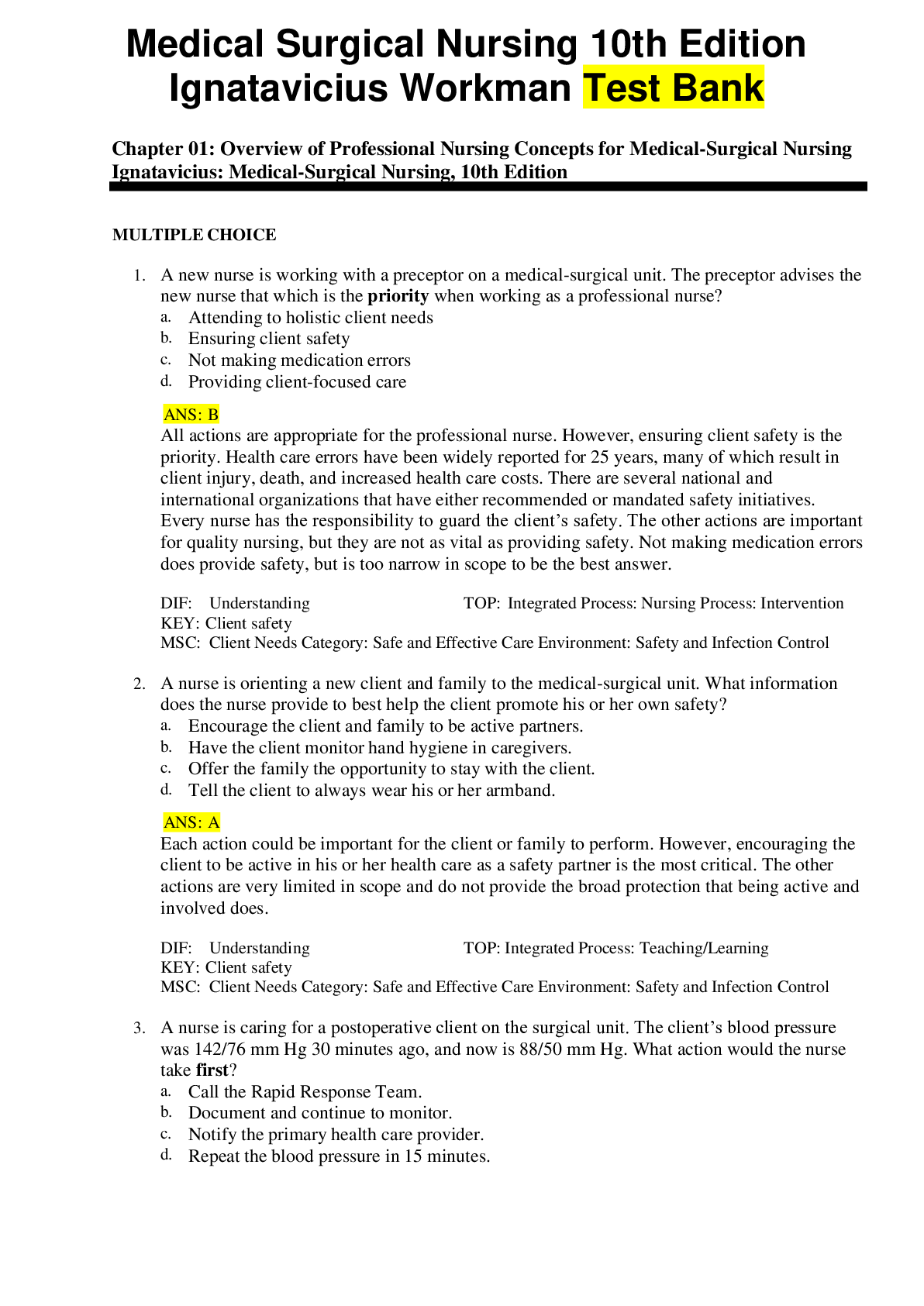

.png)


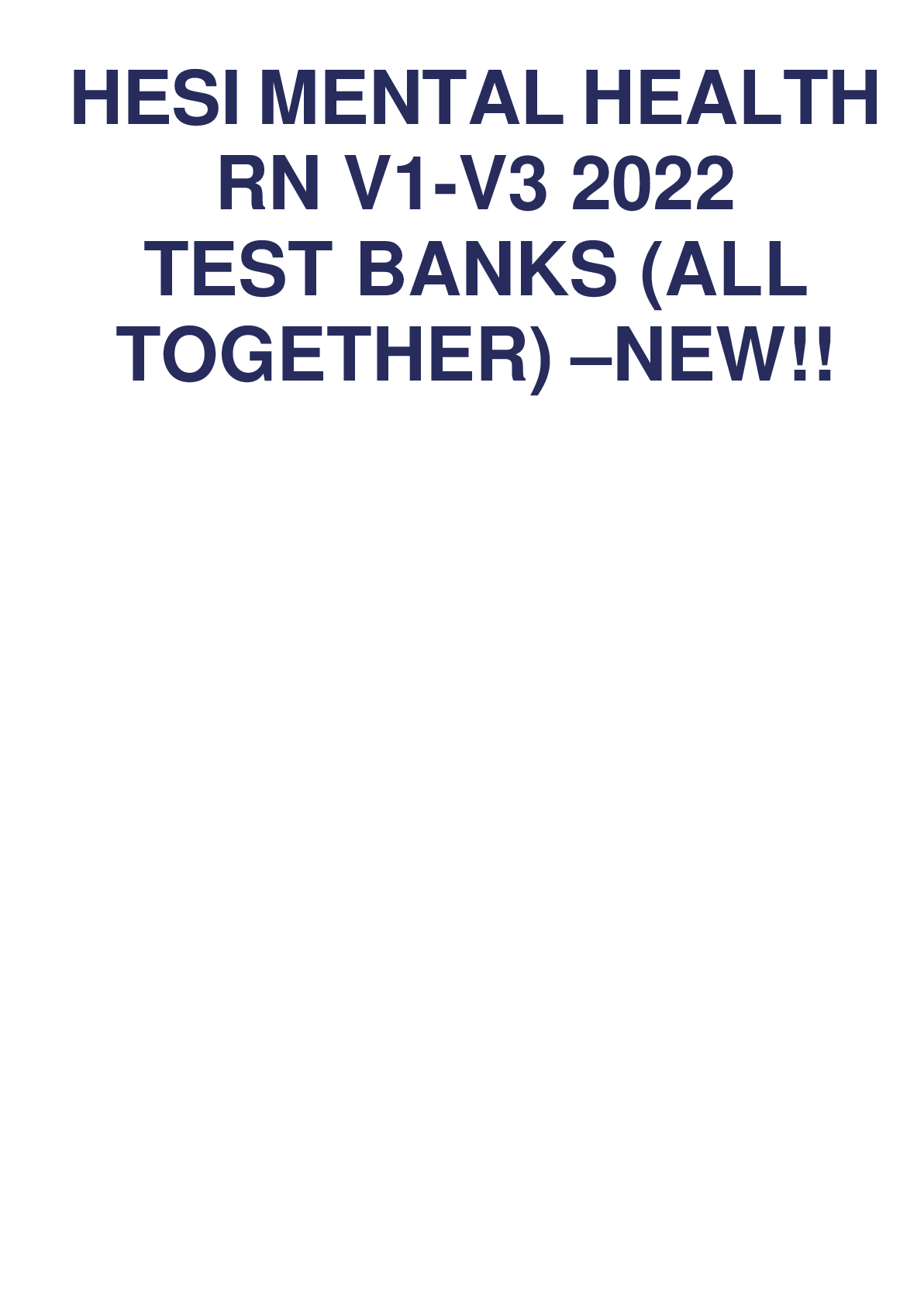
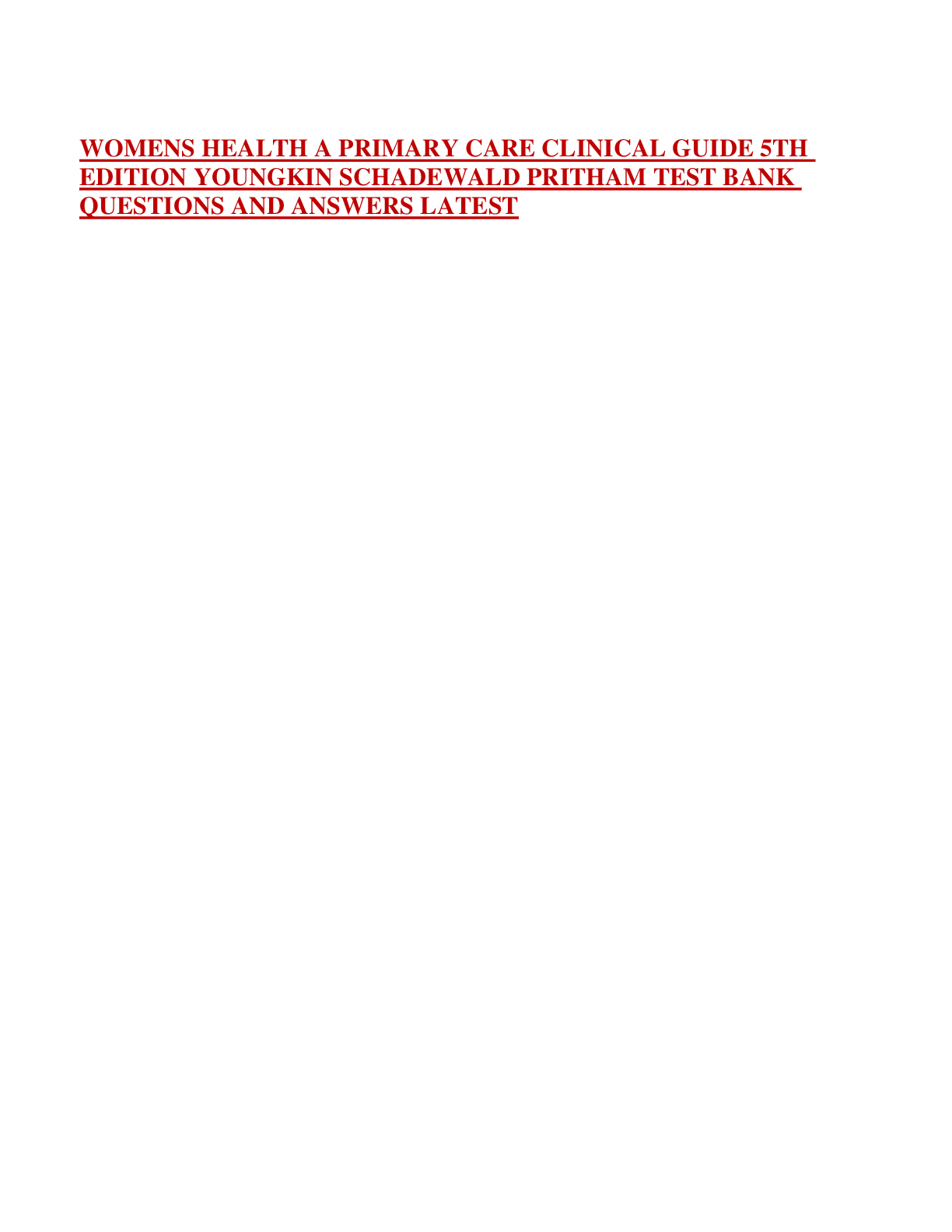



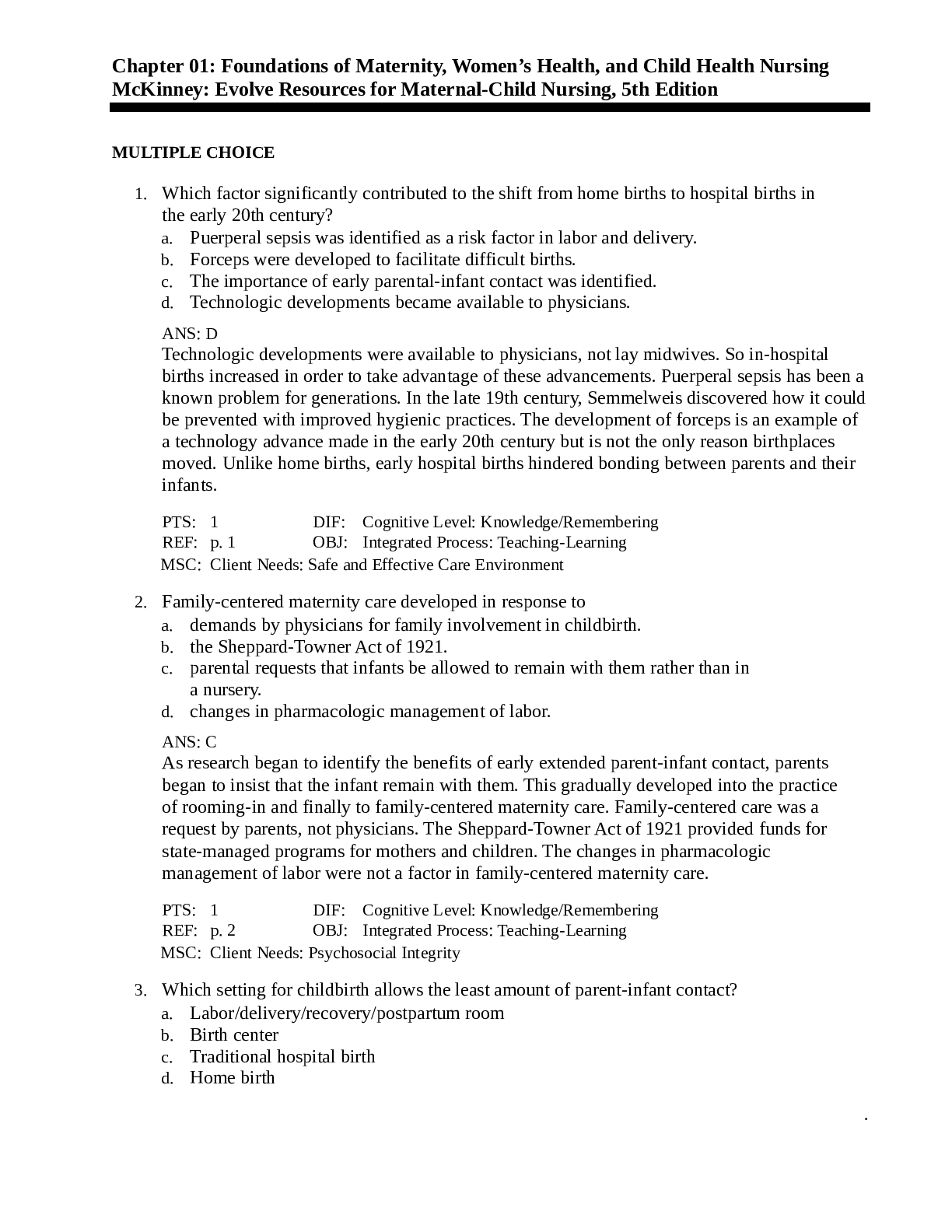


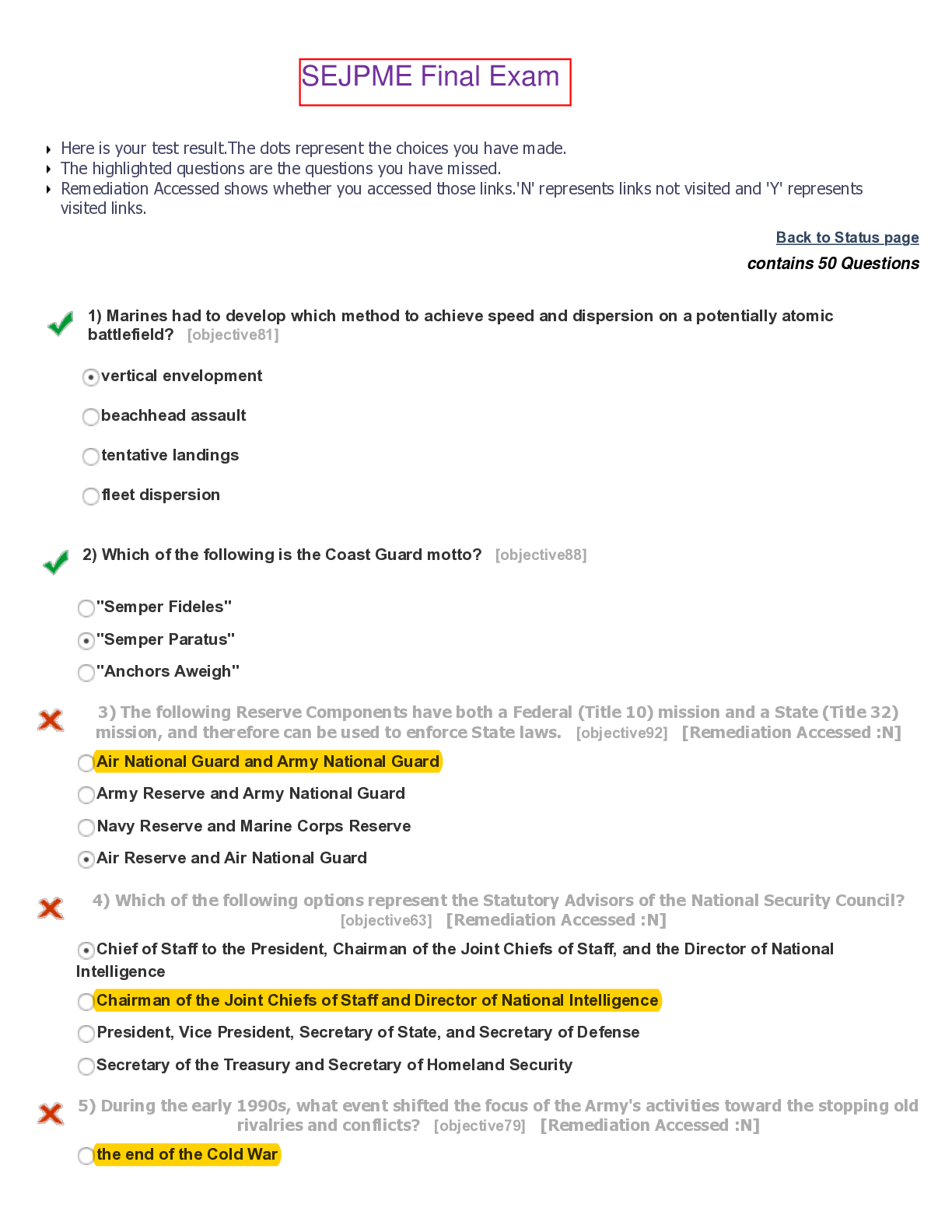
.png)
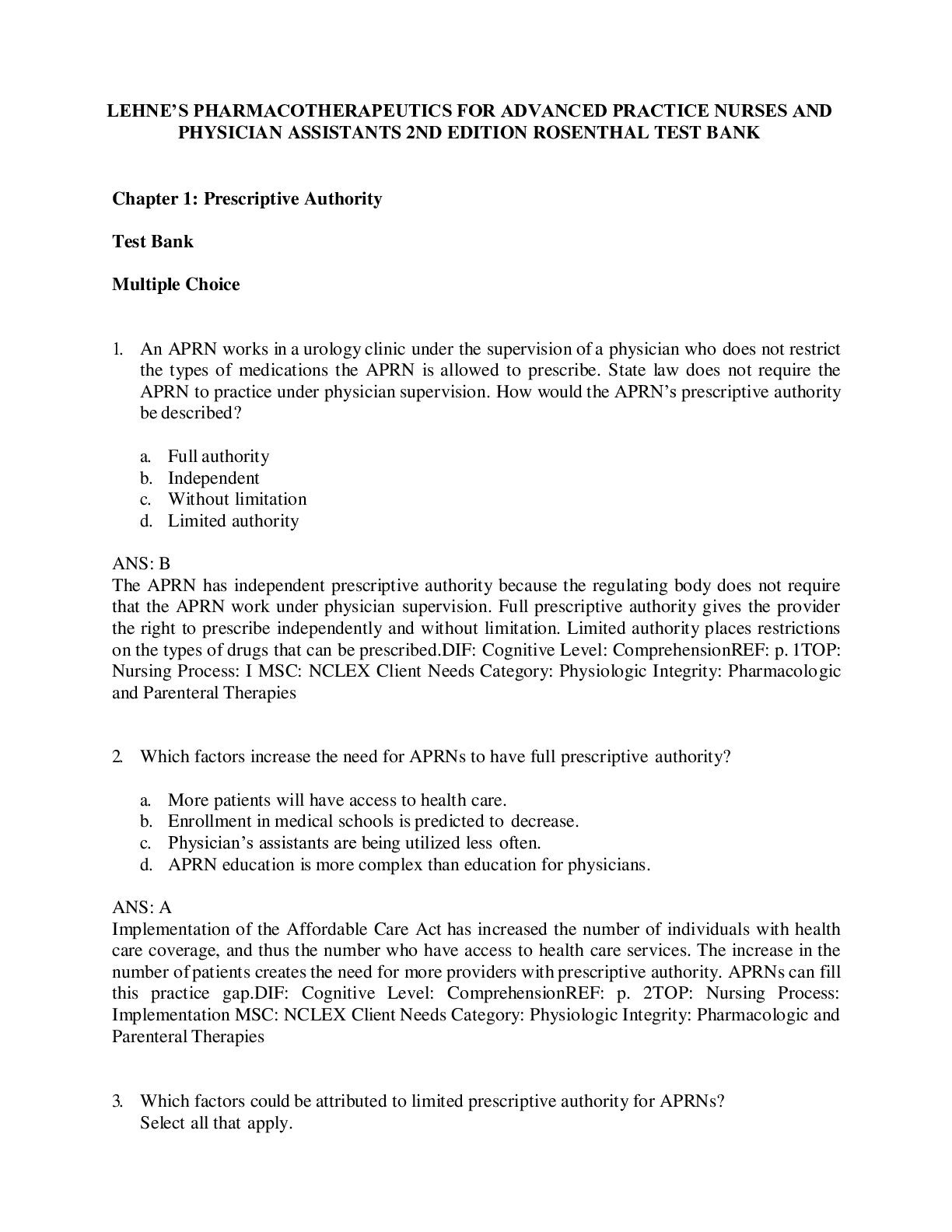

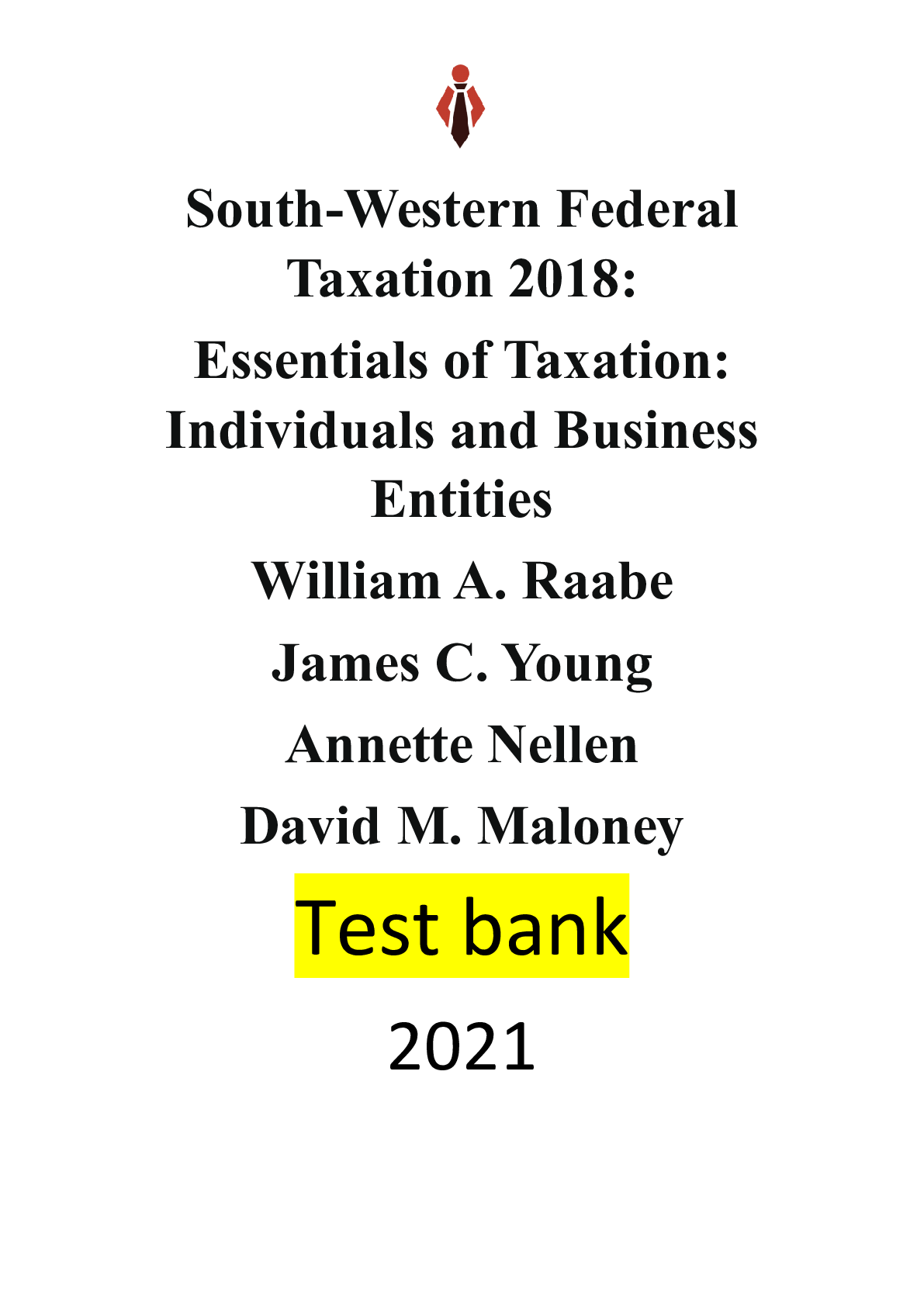
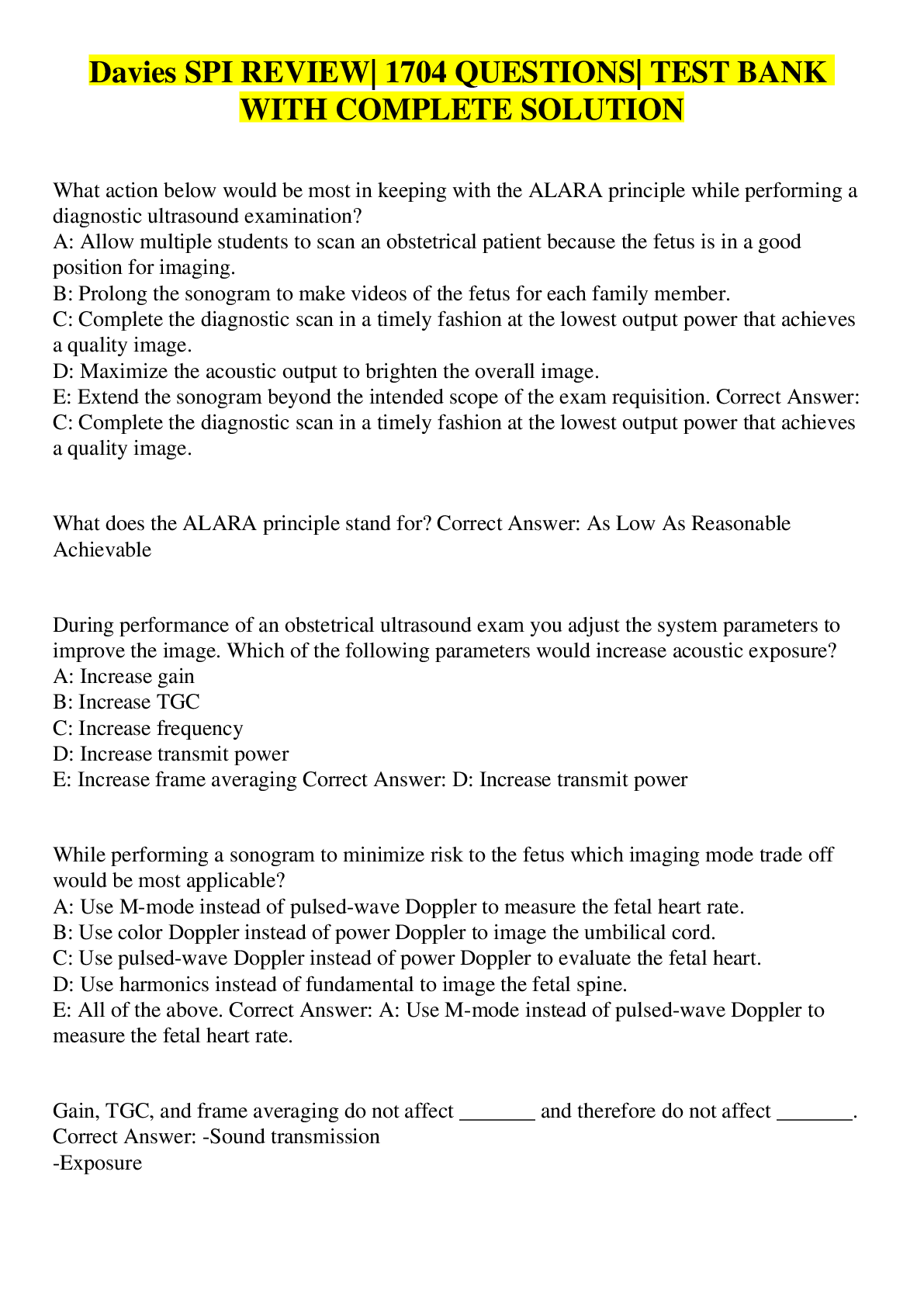

.png)
.png)
 A+ guide.png)
